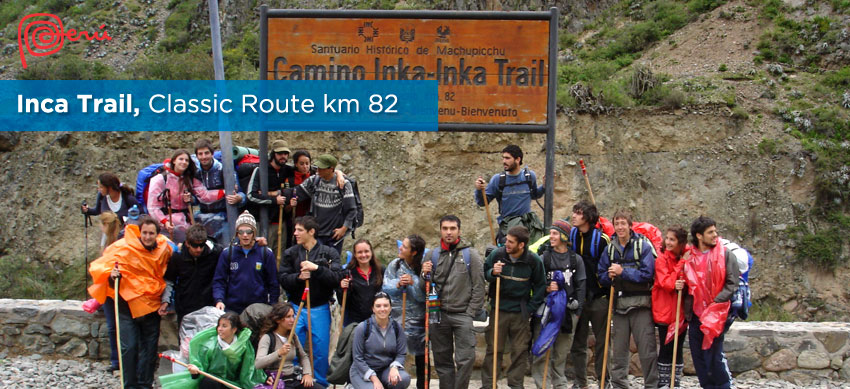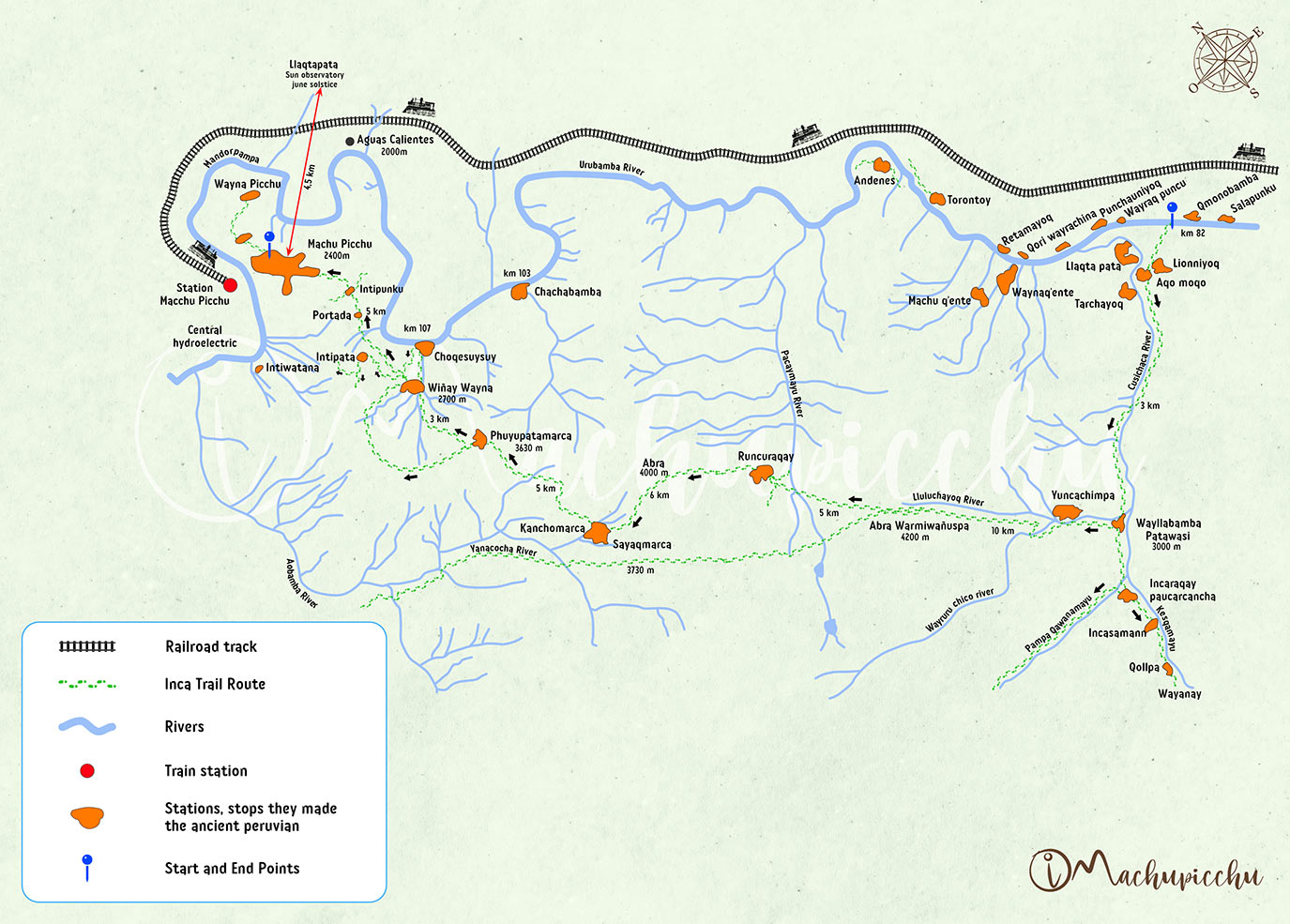
The Classic Inca Trail lasts 4 days, covers 39 kilometers in total, ends in Machu Picchu and is considered the best hiking route in Cusco and Peru. Its roads are protected by the Peruvian State, so only people with permission can travel along them. These permits are only obtained by purchasing a tour through a tourism agency. Due to the high demand for tour packages, this tour must be purchased online 6 or 7 months in advance. Otherwise, you will not find availability.
Description
The Classic Inca Trail is a 4-day trekking route to Machu Picchu following the ancient trails built by the Incas (the famous route of the qhapac ñan).
The starting point is kilometer 82 of the railway that connects the towns of Ollantaytambo with Aguas Calientes. The end of the road is at the Puerta del Sol (Intipunku), the entry point to Machu Picchu used by the Incas. From there you have the first view, scenic and unforgettable, of the wonder of the world.
During the 39 kilometers of route, tourists will appreciate other citadels built by the Incas, such as: Llactapata, Runkurakay, Sayaqmarca, Phuyupatamarca, Wiñayhuayna and more.
For many people it is the most incredible and adventurous way to get to know Machu Picchu.
Summary of the route
| Difficulty | Half. Mainly moderate slopes. |
| Total distance | 43 km / 26.72 miles |
| Approximate Walking Time | Day 01: 5 – 6 hours Day 02: 6 – 7 hours Day 03: 7 – 8 hours |
| Maximum Altitude | 4,200 m / 13,779 ft |
| Altitud Minima | 2,550 m / 8,366 ft |
| Maximum T° | Sobre 20°C |
| Minimum T° | Sobre 0°C |
Classic Inca Trail Route
How is the walk day by day?
First day – Very early in the morning, you leave by minivan towards km 82 of the train track (near the town of Ollantaytambo). There begins the trek uphill for 5, 6 hours or more. Finally in the Huayllabamba camp where you have lunch and spend the night. That day the archaeological site of Patallacta will be appreciated and approximately 13 kilometers will be covered.
Second day – Day 2 is considered the most difficult. Start early with breakfast and the start of the trek. After a few hours we will arrive at the ‘abra Warmiwañusca’, the highest point of the Inca Trail (4,200 meters above sea level). Then begins a slight descent until reaching the Pacaymayu camp. There you will have lunch and spend the night after an average of 11 kilometers of walking. That day the tourists will be able to observe the archaeological site of Runkurakay.
Third day – On the third day, the cold mountain landscape gives way to the mysterious vegetation of the Cusco jungle. Almost all the way is downhill. After the morning breakfast, we arrive at the Wiñayhuayna camp where, after a nutritious lunch, we camp. That day will travel 16 kilometers on average. The archaeological sites of Sayaqmarca and Wiñayhuayna will also be visited.
Fourth day – On the last day, after breakfast, there is only a short walk (approximately 3 kilometers) until arriving at Machu Picchu. In the Intipunku you get the first view of the Inca city. This first impression, according to many tourists, is unforgettable due to the beauty of the landscape. In the afternoon, after touring the archaeological site with the tour guide, we return to Cusco by bus and train.
Transport
The transportation service on the Inca Trail is complete. Includes: transfer by minivan from Cusco to the starting point of the trek (kilometer 82), transportation by train from Aguas Calientes to Ollantaytambo and return by minivan from Ollantaytambo to the city of Cusco.
The train chosen for the return is ‘Expedition’, a tourist service that offers maximum comfort, large windows and sale of snacks and drinks on board. This service, in exchange for an additional cost, can be upgraded to a superior service such as the Vistadome.
Tour guide
The tour guide service accompanies the tourist from start to finish during the four days of the Inca Trail. He is a professional with command of English and Spanish. In addition, if there are more than 9 tourists in a group, an assistant tour guide will accompany them.
If the visitor wants a specialized tour guide in a language other than Spanish or English, they must request a private service. These are personalized guides for the tourist, his family, group of friends or couple. The cost is higher than the normal service (shared).
Porters
Porters are essential for the Inca Trail to take place. These people, residents of the small towns of Cusco for the most part, are in charge of moving on their backs the necessary utensils for the camp and the feeding of the visitors. In some cases, they also carry part of the tourists’ luggage.
The porters say goodbye to the visitor on the afternoon of the third day of the route. That night the tourists agree to offer a tip for the entire team that accompanied them during the walk (guides, porters, cooks, etc.). In addition to the number of necessary porters, if the tourist needs an additional one, he can request it in exchange for an extra cost.
Cooks
The cooks are professionals specialized in preparing nutritious dishes with Andean ingredients such as potatoes, corn, quinoa, goose, etc. In each camp food will be served promptly. The tour will include three breakfasts, three lunches and three dinners.
Tourists with different food options such as vegetarians or vegans can request special dishes for them. All tours to the Inca Trail offer this possibility, as long as the request is made in advance.
Camps
During the four days that the Inca Trail lasts, tourists will spend three nights in excellently equipped camps. The camps are already defined and are held in the towns of: Huayllabamba, Pacaymayu and Wiñayhuayna (or Puyupatamarca, as established by the authorities).
Entrance to Machu Picchu
The entrance ticket to the Inca city is called ‘Machu Picchu Solo’. It is the ticket most used by visitors to discover the wonder of the world. It allows you to visit the entire archaeological site including its main buildings such as: the Intipunku, the Intihuatana, the Temple of the Sun, the Main Temple, the Temple of the Condor, the Sacred Rock and more.
In case the visitor is looking for a few more doses of adventure, they can purchase the ticket ‘Machu Picchu with Huayna Picchu’. This ticket, in addition to the classic tour of the Inca city, allows you to ascend to the top of the Huayna Picchu mountain. The tourist must pay approximately 20 dollars to acquire this ticket.
Other services included
The Inca Trail also includes an emergency kit in case tourists need it. Tents are also included.
The foods not included are: a breakfast (first day), a lunch (fourth day) and a dinner (fourth day). Sleeping bags are also not included as they are personal items.
Useful facts and tips
The 4-day Classic Inca Trail is a highly requested route by tourists. But to get availability you must buy a tour 6 or 7 months in advance. Otherwise you will not find a tour available.
It is not necessary to have a great physical condition to carry out this hiking route. Enjoying walking outdoors is enough. However, it is always advisable to be used to physical exercises.
Due to the constant rains, throughout February, the Inca Trail remains closed to the public. On those days cleaning work is carried out on the route.
Frequently asked questions by tourists
1) How much does the Classic Inca Trail cost?
Check the prices of the 4-day Classic Inca Trail.
2) Is the route safe?
Yes, this hiking trail is considered safe. In February, the month with the most rains and landslides, the roads are closed for prevention.
3) Can I choose the camp where I sleep the third night?
The third night there are two camping options for the tourist: Wiñayhuayna or Puyupatamarca. The tourist does not decide in which camp to sleep. The authorities of the Ministry of Culture of Peru are the ones who decide according to current availability.
4) Do the tours include bus descent from Machu Picchu to Aguas Calientes?
No, this service is optional (a cost of 12 dollars). Many tourists prefer to walk down to Aguas Calientes (easy and free walk of approximately 2 hours).
5) Will the same Inca Trail tour guide accompany me to Machu Picchu?
Yes, the same tour guide that will accompany the tourist on the 3 days of the Inca Trail, will accompany him on the tour of Machu Picchu.
6) When is a good time to go?
According to expert tour guides on the Inca Trail, the dry season months are the best to go. These are: May, June, July, August, September and even October.
7) Can I go with children?
Yes, although it is recommended to go with children over 8 years old and who like long walks.
8) Are there discounts?
Yes, people under the age of 18, university students and citizens of the Andean Community of Nations (Peru, Colombia, Ecuador and Bolivia) have a discount on the Inca Trail.
9) Can I cancel a tour to the Inca Trail?
No, unfortunately the Inca Trail is an impossible route to cancel due to provisions of the Peruvian Ministry of Culture. Any tourism agency will not allow you to cancel a tour already purchased.
10) What do I do if I don’t get availability?
In case you do not find availability for the Inca Trail, you can find another later date for your adventure. Otherwise you can choose a different trekking route such as: the 2-day Inca Trail, the 5-day Salkantay trek, the 4-day Lares trek, the 3-day Huchuy Qosqo trek or the 4-day Inca Jungle.
By Inca Trail Machu Picchu - Last updated, 22-08-2024
Interested in the Inca Trail? Know more about Routes!
- Tours to the Inca Trail: Hiking and adventure
- Differences between Inca Trail and Alternate Treks
- Differences between the 4-day Inca Trail and the Salkantay Trek to Machu Picchu
- What will we find in Hydroelectric? – Details of economic route to Machu Picchu
- Are there hiking trails near Machu Picchu?
- Why do a hiking route in Cusco?

